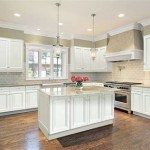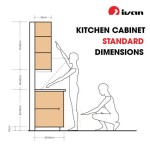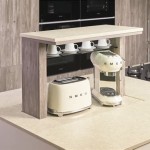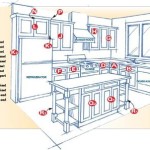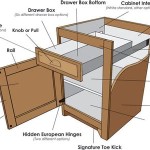What Is Standard Kitchen Drawer Width?
Determining the standard width of kitchen drawers is not as straightforward as a single, fixed measurement. Kitchen design involves a multifaceted approach, considering factors like overall kitchen size, cabinet configuration, and the specific function each drawer is intended to serve. While no universally mandated width exists, certain dimensions are frequently encountered throughout the industry, offering a practical framework for planning and renovation.
Understanding these commonly used widths can significantly benefit homeowners, interior designers, and contractors during the kitchen planning process. It allows for efficient space utilization, optimized storage solutions, and a visually harmonious appearance, all crucial for a functional and aesthetically pleasing kitchen.
This article will explore the typical range of kitchen drawer widths, detailing the factors influencing these dimensions and providing insights into how these widths are applied in practical kitchen design scenarios. By understanding these principles, individuals can make informed decisions regarding their kitchen layouts and storage solutions.
Understanding the Range of Common Kitchen Drawer Widths
The term "standard" in kitchen design often refers to commonly used or readily available sizes, rather than a legally enforced regulation. Kitchen drawers, while variable, generally fall within a specific range of widths, accommodating a wide variety of storage needs. These standard sizes allow for maximizing storage utilization and ease of access.
Typically, kitchen drawer widths range from 12 inches to 36 inches. However, this is a broad spectrum, and specific increments are more prevalent. For instance, drawers with widths of 15, 18, 24, 30, and 36 inches are frequently encountered. These measurements are often tied to standard cabinet module sizes, ensuring compatibility and efficient material usage during manufacturing and installation.
Smaller drawers, such as those 12 inches or less in width, are often used for storing utensils, spices, or smaller kitchen gadgets. These drawers are particularly useful in areas where space is limited, or as filler drawers to complete a cabinet run. Wider drawers, ranging from 30 to 36 inches, provide ample storage for larger items, such as pots, pans, and serving dishes. Due to their increased width, these drawers require robust construction and high-quality drawer slides to support heavier loads and ensure smooth operation.
The selection of drawer widths should be directly related to the items intended for storage. Planning a drawer’s contents beforehand is crucial for determining the optimal width. This approach ensures that the drawer is neither too large (resulting in wasted space) nor too small (leading to overcrowding and difficulty in accessing items).
Beyond the width itself, the construction and materials used in the drawer are critical. Wider drawers require stronger materials, such as hardwood or high-density particleboard, to prevent sagging or warping over time. Similarly, durable drawer slides, rated for the expected weight load, are essential for ensuring smooth and reliable operation, particularly for larger drawers.
Specialty drawers, such as pull-out trash or recycling drawers, might deviate from these standard widths. These specialized drawers often require custom dimensions based on the specific insert or mechanism they house. It is important to consider these specific requirements when planning the overall kitchen layout.
Ultimately, the "standard" width is not a rigid rule but a guideline. A successful kitchen design will incorporate a variety of drawer widths, carefully selected to meet the storage needs of the homeowner and the spatial constraints of the kitchen itself.
Factors Influencing Kitchen Drawer Width Selection
Numerous factors influence the selection of kitchen drawer widths. These factors extend beyond simply matching the size of the items to be stored. Considerations such as overall kitchen size, cabinet configuration, kitchen workflow, and individual homeowner preferences all play critical roles in determining the optimal drawer dimensions.
The overall size of the kitchen is a primary driver of drawer width. In smaller kitchens, maximizing storage density is paramount. Utilizing narrower drawers, and incorporating vertical storage solutions such as drawer dividers and organizers, becomes crucial. Conversely, in larger kitchens, wider drawers might be feasible and even desirable, allowing for the convenient storage of bulky items.
The cabinet configuration significantly impacts the available drawer widths. Base cabinets, the most common location for drawers, typically come in standard widths, such as 30 inches or 36 inches, influencing the dimensions of the drawers they contain. Island cabinets, often designed with drawers facing outwards for easy access, can also significantly affect the overall drawer layout. It is essential to consider the relationship between the cabinet modules and the desired drawer widths during the planning phase.
Understanding the kitchen workflow is crucial for strategic drawer placement and width selection. Drawers located near the cooking area should be designed to store frequently used cooking utensils, spices, and cookware. Drawers near the preparation area should accommodate cutting boards, mixing bowls, and knives. Optimizing drawer placement based on workflow improves efficiency and reduces unnecessary movement within the kitchen.
Homeowner preferences are paramount. Some homeowners prefer a uniform aesthetic, opting for drawers of consistent widths. Others prioritize maximizing storage capacity and embrace a more varied approach to drawer dimensions. Understanding the homeowner's needs and preferences is essential for creating a customized and satisfying kitchen design.
Drawer depth also plays a significant role in usability. Deeper drawers are ideal for storing tall items, such as bottles or containers. Shorter drawers are better suited for flat items, such as utensils or silverware. The combined consideration of drawer width and depth is critical for efficient storage.
Budget considerations can also influence drawer width choices. Custom drawer sizes or configurations often incur higher costs compared to standard options. Balancing desired functionality with budgetary constraints is important when making decisions about drawer dimensions.
Accessibility is another factor. Wider drawers can be difficult to open and close if not properly supported, especially when fully loaded. Ensuring the drawers are easily accessible, even when filled with heavy items, is critical.
Practical Applications of Standard Drawer Widths in Kitchen Design
The practical application of standard drawer widths is crucial for effective kitchen design. Understanding how these widths are implemented in different storage scenarios optimizes both functionality and aesthetic appeal. The successful integration of standard drawer widths requires careful planning and consideration of specific storage needs.
In the area near the cooktop or range, drawers of 15 to 18 inches wide are ideal for storing cooking utensils, such as spatulas, ladles, and tongs. These drawers provide easy access to essential tools during meal preparation. A dedicated spice drawer, typically 12 inches wide, can keep frequently used spices organized and within reach. Utilizing drawer dividers or inserts keeps utensils neatly separated and prevents them from becoming jumbled.
Underneath the countertop, drawers of 24 to 30 inches wide are commonly used for storing food preparation items, such as cutting boards, mixing bowls, and measuring cups. These drawers offer ample space for storing larger items. Utilizing drawer organizers can help keep contents neatly arranged and prevents items from sliding around when the drawer is opened and closed.
For storing pots, pans, and other cookware, wider drawers of 30 to 36 inches wide are recommended. These drawers provide sufficient space for accommodating bulky items. Heavy-duty drawer slides are essential for supporting the weight of the cookware. Using drawer liners can protect the drawer bottom from scratches and dents.
Drawers located near the sink are often used for storing dish towels, cleaning supplies, and other kitchen essentials. A drawer width of 18 to 24 inches is generally sufficient for these items. Consider incorporating a pull-out trash or recycling drawer near the sink. The width of this drawer will depend on the size of the trash can or recycling bin.
In island kitchens, drawers can be strategically placed for storing a variety of items. Wider drawers can be used for storing serving dishes, placemats, and napkins. Smaller drawers can be used for storing silverware, knives, and other small utensils. The drawer placement on the island can also provide additional work space for food preparation.
Pantry cabinets often incorporate drawers for storing dry goods, snacks, and canned goods. Drawers of varying widths can be used to accommodate different types of items. Wider drawers can be used for storing cereal boxes and large containers, while narrower drawers can be used for storing snacks and canned goods. Adjustable drawer heights can also be beneficial for accommodating items of varying sizes.
When planning drawer layouts near appliances like dishwashers and refrigerators, consider ergonomics and accessibility. Drawers intended for storing plates, bowls, or cutlery used directly from the dishwasher should be positioned for easy unloading. Similarly, drawers near the refrigerator should be designed for storing frequently used ingredients or snacks.

Cabinet Sizes Blok Designs Ltd

Kitchen Cabinet Drawer Dimensions Standard Inspiration Ideas 3 Decorating Cabinets Height Sizes

N Standard Kitchen Dimensions Renomart

Cabinet Face Dimensions

View Topic Show Your Walk In Pantry Home Renovation Building Forum Kitchen Cabinet Drawers Base Cabinets Dimensions

When Is A Drawer Too Wide Or Big

Cabinet Sizes Blok Designs Ltd

600mm 2 1 Pan Drawer Base Unit

Image Result For Kitchen Drawer Size Drawers Cabinet Cabinets
-8197-p.jpg?strip=all)
Pine Traditional Style Ascending 3 Drawer Kitchen Base Unit 600mm


